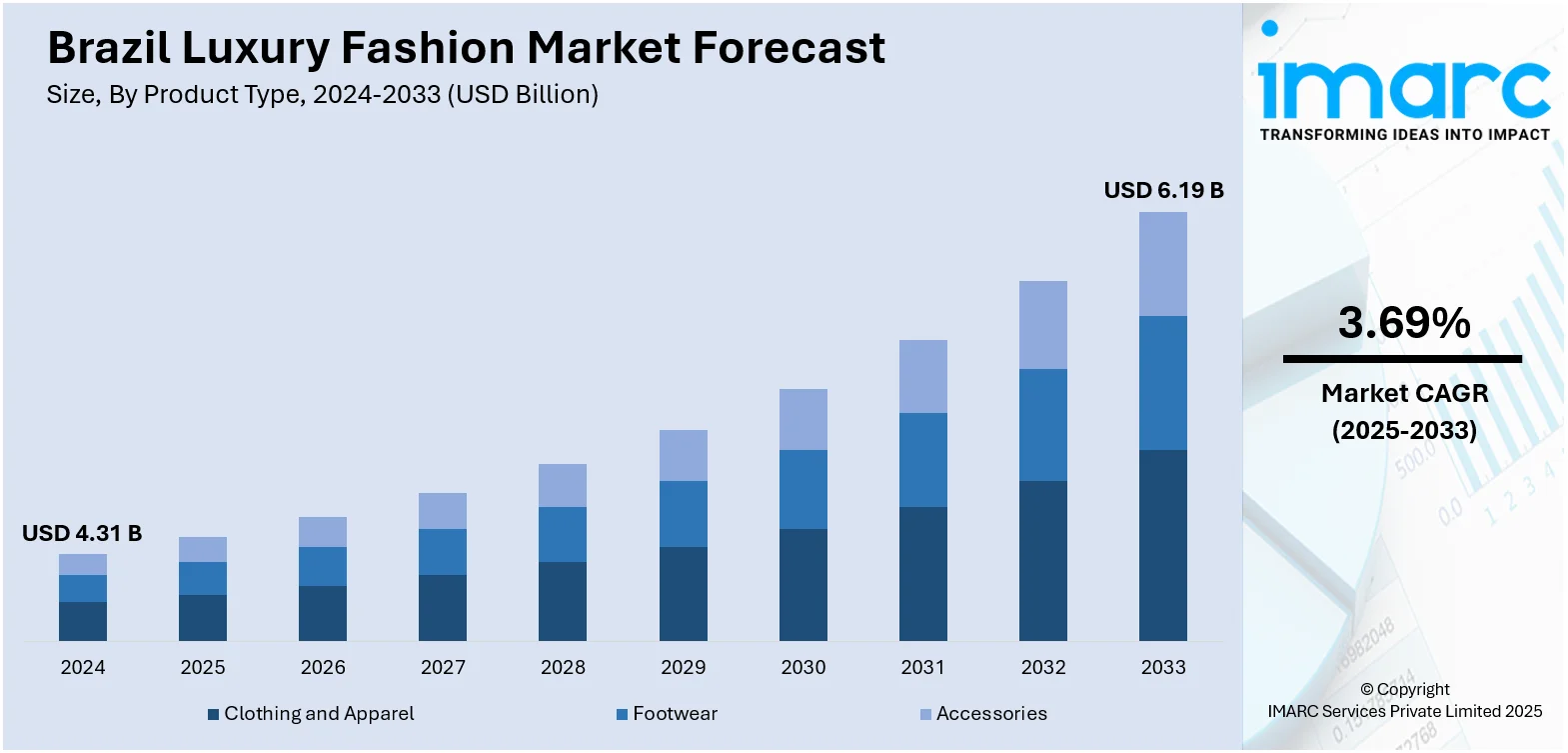
Brazil Luxury Fashion Market Size, Share, Trends and Forecast by Product Type, Distribution Channel, End User, and Region, 2025-2033
Brazil Luxury Fashion Market Overview:
The Brazil luxury fashion market size reached USD 4.31 Billion in 2024. The market is projected to reach USD 6.19 Billion by 2033, exhibiting a growth rate (CAGR) of 3.69% during 2025-2033. The market is fueled by growing disposable incomes, heightened interest in premium clothing, and enhanced international luxury brand presence. Apart from this, online growth through e-commerce and social media platforms has increased the availability and desirability of luxury fashion among young consumers. Besides that, the desire for rarity and bespoke shopping is encouraging brands to place investments in premium retail formats and local partnerships, which is augmenting the Brazil luxury fashion market share.
|
Report Attribute
|
Key Statistics
|
|---|---|
|
Base Year
|
2024 |
|
Forecast Years
|
2025-2033
|
|
Historical Years
|
2019-2024
|
| Market Size in 2024 | USD 4.31 Billion |
| Market Forecast in 2033 | USD 6.19 Billion |
| Market Growth Rate 2025-2033 | 3.69% |
Brazil Luxury Fashion Market Trends:
Rising Disposable Income Among Affluent Consumers
One of the most impactful trends driving the market is the increasing growth in disposable income among high-income and upper-middle groups. Economic robustness in urban areas has driven growth in a consumer base that is more willing to spend on high-end fashion and accessories. Industry data indicate that Brazil's real GDP grew 3.4% in 2024, increasing spending confidence among high-income groups. This transformation is particularly observable in urban areas such as São Paulo, Brasília, and Rio de Janeiro, where there is still demand for luxury products. These buyers, who mainly consist of professionals, corporate executives, and entrepreneurs, perceive luxury fashion as a status symbol, both in terms of recognition and elevation of lifestyle, and thus are a stable target for premium brands looking to grow in the region. This rise in purchasing power has also transformed buying behavior from sporadic indulgence to consistent interaction with luxury brands. Consumers are now more likely to seek full-price, new-season items rather than wait for promotions or travel abroad for purchases. Consequently, brands are increasing their local presence and availability of inventory. This trend has also spurred the expansion of luxury shopping centers and VIP loyalty programs, since brands are seeking to better serve a more active and stable set of high-spending customers.

To get more information on this market, Request Sample
Emergence of Digital Luxury Commerce
The shift toward digital platforms is positively impacting the Brazil luxury fashion market growth. High-end brands are moving beyond traditional retail formats and investing in localized e-commerce strategies that align with the shopping habits of Brazilian consumers. This shift is not only about convenience, but it also reflects a broader change in how luxury is accessed and experienced. In 2024, internet penetration in Brazil reached about 86.6% of the population, totaling 187.9 million users, creating a large and connected audience for digital retail. Smartphone adoption and high social media engagement, especially among affluent millennials and Gen Z in cities like São Paulo and Rio de Janeiro, are reshaping the way consumers interact with luxury brands. This digital transformation is helping luxury labels expand their reach beyond traditional customer bases, making online presence a strategic priority in the Brazilian market. In response, brands are adopting omnichannel strategies, integrating digital touchpoints with physical stores to create unified shopping journeys. Social media is also playing a critical role in shaping purchase behavior, with platforms like Instagram and TikTok becoming spaces for product discovery, influencer engagement, and direct sales. Brazilian luxury shoppers are now demanding real-time interactions, exclusive online drops, and content-rich storytelling, prompting brands to rethink how they launch and market collections digitally. This trend is accelerating investment in localized logistics, digital payment systems, and online concierge services.
Brazil Luxury Fashion Market Segmentation:
IMARC Group provides an analysis of the key trends in each segment of the market, along with forecasts at the country and regional levels for 2025-2033. Our report has categorized the market based on product type, distribution channel, and end user.
Product Type Insights:
- Clothing and Apparel
- Jackets and Coats
- Skirts
- Shirts and T-Shirts
- Dresses
- Trousers and Shorts
- Denim
- Underwear and Lingerie
- Others
- Footwear
- Accessories
- Gems and Jewellery
- Belts
- Bags
- Watches
The report has provided a detailed breakup and analysis of the market based on the product type. This includes clothing and apparel (jackets and coats, skirts, shirts and T-shirts, dresses, trousers and shorts, denim, underwear and lingerie, and others), footwear, and accessories (gems and jewellery, belts, bags, and watches).
Distribution Channel Insights:

- Store-Based
- Non-Store Based
A detailed breakup and analysis of the market based on the distribution channel have also been provided in the report. This includes store-based and non-store based.
End User Insights:
- Men
- Women
- Unisex
The report has provided a detailed breakup and analysis of the market based on the end user. This includes men, women, and unisex.
Regional Insights:
- Southeast
- South
- Northeast
- North
- Central-West
The report has also provided a comprehensive analysis of all the major regional markets, which include Southeast, South, Northeast, North, and Central-West.
Competitive Landscape:
The market research report has also provided a comprehensive analysis of the competitive landscape. Competitive analysis such as market structure, key player positioning, top winning strategies, competitive dashboard, and company evaluation quadrant has been covered in the report. Also, detailed profiles of all major companies have been provided.
Brazil Luxury Fashion Market News:
- August 2024: Balenciaga unveiled a sleek new boutique in São Paulo's prestigious Iguatemi Shopping Center, marking its third store in Brazil and reaffirming the brand's commitment to the South American market. The ultra-modern space spans nearly 200 m² and aligns with the mall's luxury positioning alongside brands such as Loewe and Chanel. This expansion reflects Balenciaga's strategy to deepen regional presence by delivering localized luxury experiences in key Brazilian markets.
Brazil Luxury Fashion Market Report Coverage:
| Report Features | Details |
|---|---|
| Base Year of the Analysis | 2024 |
| Historical Period | 2019-2024 |
| Forecast Period | 2025-2033 |
| Units | Billion USD |
| Scope of the Report | Exploration of Historical Trends and Market Outlook, Industry Catalysts and Challenges, Segment-Wise Historical and Future Market Assessment:
|
| Product Types Covered |
|
| Distribution Channels Covered | Store-Based, Non-Store Based |
| End Users Covered | Men, Women, Unisex |
| Regions Covered | Southeast, South, Northeast, North, Central-West |
| Customization Scope | 10% Free Customization |
| Post-Sale Analyst Support | 10-12 Weeks |
| Delivery Format | PDF and Excel through Email (We can also provide the editable version of the report in PPT/Word format on special request) |
Key Questions Answered in This Report:
- How has the Brazil luxury fashion market performed so far and how will it perform in the coming years?
- What is the breakup of the Brazil luxury fashion market on the basis of product type?
- What is the breakup of the Brazil luxury fashion market on the basis of distribution channel?
- What is the breakup of the Brazil luxury fashion market on the basis of end user?
- What is the breakup of the Brazil luxury fashion market on the basis of region?
- What are the various stages in the value chain of the Brazil luxury fashion market?
- What are the key driving factors and challenges in the Brazil luxury fashion market?
- What is the structure of the Brazil luxury fashion market and who are the key players?
- What is the degree of competition in the Brazil luxury fashion market?
Key Benefits for Stakeholders:
- IMARC’s industry report offers a comprehensive quantitative analysis of various market segments, historical and current market trends, market forecasts, and dynamics of the Brazil luxury fashion market from 2019-2033.
- The research report provides the latest information on the market drivers, challenges, and opportunities in the Brazil luxury fashion market.
- Porter's five forces analysis assist stakeholders in assessing the impact of new entrants, competitive rivalry, supplier power, buyer power, and the threat of substitution. It helps stakeholders to analyze the level of competition within the Brazil luxury fashion industry and its attractiveness.
- Competitive landscape allows stakeholders to understand their competitive environment and provides an insight into the current positions of key players in the market.
Need more help?
- Speak to our experienced analysts for insights on the current market scenarios.
- Include additional segments and countries to customize the report as per your requirement.
- Gain an unparalleled competitive advantage in your domain by understanding how to utilize the report and positively impacting your operations and revenue.
- For further assistance, please connect with our analysts.
 Request Customization
Request Customization
 Speak to an Analyst
Speak to an Analyst
 Request Brochure
Request Brochure
 Inquire Before Buying
Inquire Before Buying




.webp)




.webp)












